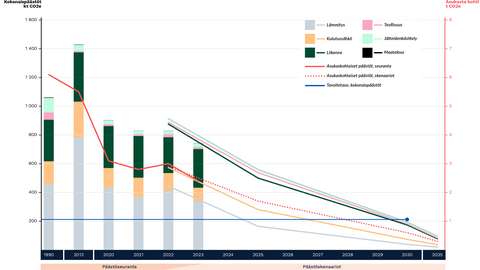Espoo's emissions have decreased significantly
Espoo’s emissions are declining rapidly. In 2023, the city’s emissions reduction exceeded the target level. The per capita emissions were still the lowest in the Helsinki Metropolitan Area.
Espoo’s emissions have already declined by 30%
Espoo’s goal is to reach carbon neutrality by 2030. Compared to the reference year of 1990, the amount of emissions produced in Espoo has already decreased by 30 per cent, while the city’s population has grown rapidly. The per capita emissions have decreased by 62 per cent since 1990.
The City Council of Espoo introduced the Carbon-neutral Espoo 2030 roadmap in May 2024. The 2023 emissions level fell below the annual target emission reduction rate. In other words, the emissions decreased faster than anticipated. Emissions were reduced in all sectors relevant to the carbon neutrality target: district heating, household electricity and traffic.
“It is wonderful that we are moving towards our climate goal faster than anticipated. This would not have happened without the determined joint efforts of the entire Espoo community, including the city, residents, businesses, educational institutions and research institutes. We will continue this
work in future. At the same time, we are creating sustainable growth, vitality, well-being and jobs in Finland and Espoo,” says Jukka Mäkelä, Mayor of Espoo.
Compared to 2022, the city’s emissions decreased by 17 per cent in 2023. The total amount of emissions was 742 kt CO2e, and the city’s goal is to reduce its emissions to 212 kt CO2e by 2030. Espoo’s per capita emissions were the lowest in the Helsinki Metropolitan Area for the eighth consecutive year. The per capita emissions were 2.4 t CO2e.
Significant decrease in emissions from district heating and household electricity
Together with energy company Fortum, Espoo is committed to achieving carbon-neutral district heat by the end of this decade. The use of coal and oil was reduced significantly in the production of district heat in 2023, and the use of coal ended completely in April 2024. The district heating emissions have decreased by 27 per cent from 1990.
The decrease in emissions from household electricity is explained by the reduction of the national emission factor for electricity. The household electricity emissions were 38 per cent lower than in 1990. Other measures to increase renewable and carbon-neutral energy, such as phasing out oil heat and investing in solar panels, will also reduce climate emissions.
Traffic emissions are on the decrease
Compared to 1990, emissions from traffic decreased by seven per cent in 2023. For a growing city, the reduction of total traffic emissions is an ambitious goal and a great achievement. The traffic emissions were reduced by the increased popularity of sustainable transport, i.e. walking, cycling and public transport, and the rapid electrification of the vehicle stock.
Espoo has made great investments in sustainable traffic. The city’s public transport has improved thanks to the West Metro and light rail line 15. The share of sustainable transport, i.e. public transport, cycling and walking, rose to 60 per cent in 2023. Public transport has the highest potential emission reduction due to the longer distances of travel, but the city is also investing in enabling walking and cycling to supplement public transport. Walking and cycling have a great impact on the comfort and social sustainability of the city’s urban centres.
In 2023, sustainable power sources in road traffic, i.e. electric, hybrid and gas-operated cars, made up 21 per cent of the vehicle stock in Espoo. In February, 65 per cent of the cars registered for the first time in the past 12 months were electric or hybrid cars.
Espoo monitors the trend of consumption emissions
HSY’s emissions calculation for the Helsinki Metropolitan Area and Espoo’s current carbon neutrality target do not take into account the indirect emissions from consumer goods, such as food, household goods or building products. However, the city also monitors the carbon footprint of consumption and is involved in developing the calculations methods to be more accurate.
Carbon neutrality is one of the Espoo Story objectives. The Espoo City Council approved the Carbon-neutral Espoo roadmap on 20 May 2024. The European Commission has selected Espoo to contribute to the mission of delivering 100 climate-neutral and smart cities and awarded the city the EU Mission Label.
Enquiries
Previous news articles about Espoo’s climate work
31 May 2024 HSY news: Greenhouse gas emissions from the energy sector decreasing rapidly in the Helsinki metropolitan area – the use of coal decreased by over 40% (in Finnish)(external link, opens in a new window)
21 May 2024 Espoo introduces a roadmap to achieve carbon neutrality (in Finnish)
5 April 2024 Espoo residents walk and use public transport more than before
21 March 2024 European Commission awards the EU Mission Label to Espoo’s climate work
4 May 2023 More detailed information on the carbon footprint of consumption in municipalities
27 March 2023 “We need to reach the finish line together” – the mayor of Espoo invites to join the climate cooperation
28 April 2022 Espoo selected to implement EU Mission on climate-neutral and smart cities together with other pioneers
